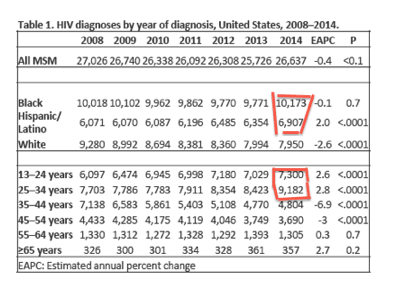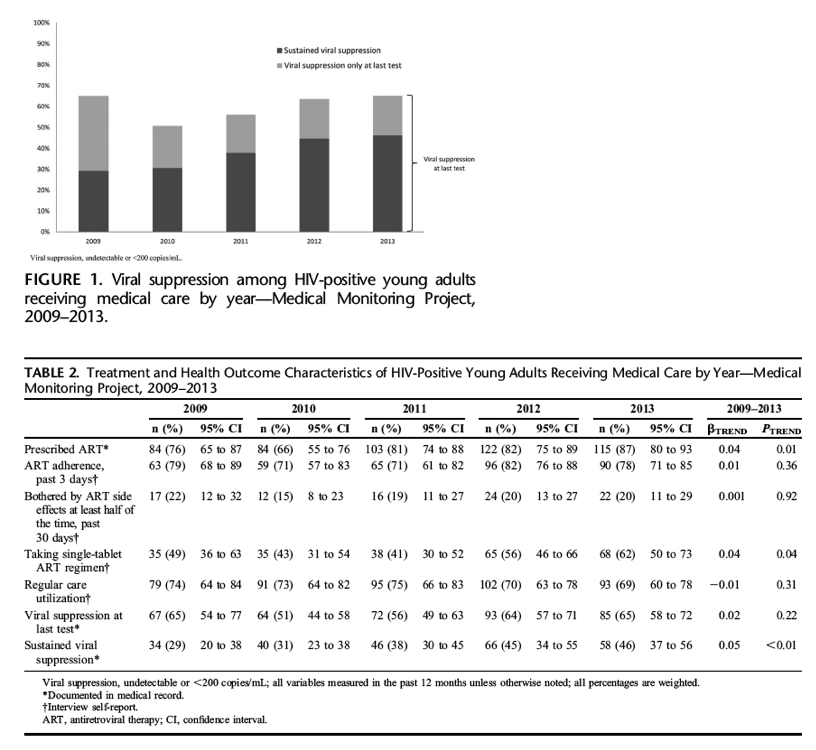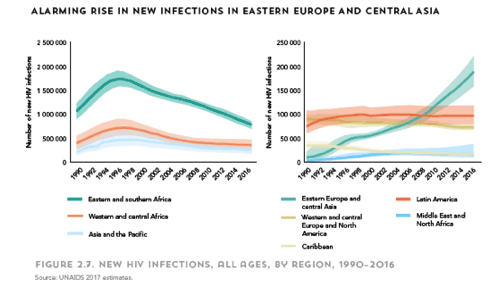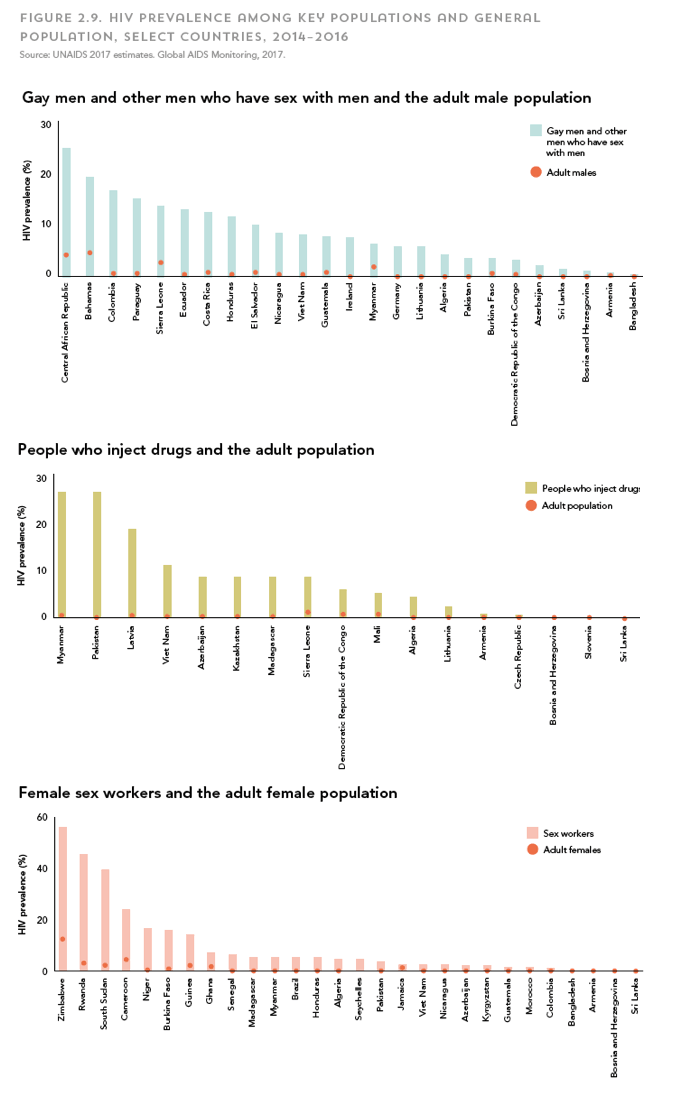| |
Ending AIDS - What is the Real prospect: New Infections
Up in Key Populations, Unsupressed Viremia High in Key Populations
|
| |
| |
CDC Reports New Infections Up in Young Men, Hispanics / Unsupressed Viremia 54%
Ending AIDS - What is the Real prospect: CDC Reports New Infections Up in Young Men, Hispanics & Unsuppressed Viremia 54%, WIHS Viral Suppression Rates, Global Key Population New Infections Up reported by UN Report, NYC HIV Prevalence & Unsuppressed Viremia Up in Report
WIHS data at CROI 2017 report discouragingly low viral suppression rates that appear to be lower than commonly thought And in NYC
CROI: Longitudinal HIV Viral Trajectories and Co-Morbidities Longitudinal in the WIHS: Viral Suppression Key to Survival - (02/16/17)
CROI: LONGITUDINAL VIRAL TRAJECTORY [and Comorbidities] AMONG WOMEN IN THE WOMEN'S INTERAGENCY HIV STUDY - (02/26/17)....20% are on HAART, 39% on ART & 30.47% of women on HAART & 38% on ART are reported here to have undetectable viral load..........5% to 11% have AIDS-associated cancer malignancies which doubled if detectable viral load, 13-15% had Non-AIDS associated cancer malignancies, 64-73% have risk factors for cardiovascular disease, 11-15% have CVD, 20% with HCV, death rate 14-30% which doubled with detectable viral load / AIDS cancer malignancies associated with detectable VL
Brief Report: HIV Prevalence and the Prevalence of Unsuppressed HIV in New York City, 2010-2014 - (05/17/17)
HIV prevalence in NYC remained unchanged at 1.22% (95% CI: 1.21% to 1.24%) in 2010 and 1.22% (95% CI: 1.20% to 1.24%) in 2014. The prevalence of unsuppressed HIV steadily decreased from 0.49% (95% CI: 0.48% to 0.51%) in 2010 to 0.34% (95% CI: 0.32% to 0.36%) in 2014 (Fig. 1)......BUT.....if you look at Table 1 you see why overall prevalence went down - because the age groups with the biggest populations 35-44 & 44-54 went down but for every other age age group prevalence increased.......
eFigure 3, http://links.lww.com/QAI/A978 shows a different pattern by age from the overall one in that male HIV prevalence increased among persons aged 25-34, 55-64, and 65+ year-olds, was stable among 18-24-year-olds, and decreased among 35-44 and 45-54-year-olds. The prevalence of unsuppressed HIV increased among 65+ year-olds and decreased in all other age groups. The 45-54-year-old group had the highest HIV prevalence (3.35% in 2014) and highest prevalence of unsuppressed HIV (0.73% in 2014).
IAS: New HIV Down in US MSM in 2008-2014, But Up in Hispanics, Younger Men - (07/28/17)

IAS: CDC Transmission Study Puts Hispanic MSM at Leading Edge of HIV Spread - Analysis of U.S. HIV sequence data indicates that recent and rapid HIV transmission is focused among young Hispanic/Latino men who have sex with men - Mark Mascolini (07/27/17)
IAS: Estimating HIV incidence and the undiagnosed HIV population in the European Union/European Economic Area - Estimated 120,000 People With Undiagnosed HIV Across Europe in 2015 - (08/07/17)
IAS: Half of HIV+ Medicaid Users Have Poor Adherence, Driving Up Costs - (08/07/17)
Trends in ART Prescription and Viral Suppression Among HIV-Positive Young Adults in Care in the United States, 2009-2013 - "sustainably virally suppressed significantly increased (29%-46%)" - (09/02/17)
HIV viral suppression is key to reducing the risk of HIV transmission, morbidity, and mortality....This analysis was guided by the following questions: have recent developments in HIV care and treatment been accompanied by increased ART prescription, adherence, and care utilization among young adults in care? If so, have these changes contributed to improvements in viral suppression?.....Although viral suppression at last test did not change over the period (65% in 2009 to 65% in 2013, βTREND = 0.02 PTREND = 0.22), the proportion of young adults who were sustainably virally suppressed significantly increased (29% in 2009 to 46% in 2013, βTREND = 0.05 PTREND ≤ 0.01). Figure 1 illustrates these findings.....partially attributable to increases in the proportions of young adults who were prescribed ART and taking single-tablet regimens......In any given year, only approximately 2/3 of young adults in HIV care were virally suppressed at last test, which is well short of the National HIV/AIDS Strategy 80% viral suppression goal for all diagnosed persons.13......However, it is important to note that the level of viral suppression among young adults in care remains low; it falls short of the National HIV/AIDS Strategy goals and is significantly lower than that found for older age groups......the lack of improvements observed among young adults suggests that wider development and implementation of effective strategies to improve adherence among young persons may be warranted......The development of injectable long-acting antitretrovirals may also prove to be a promising strategy for increasing viral suppression among this population.25

Ending AIDS: myth or reality? New Infections Increase in Key Populations, UN Update - (07/23/17)
"Yet in 2015, 15 million people living with HIV were estimated to be unaware of their status and 1⋅1 million died of AIDS-related complications, despite the fact that US$19 billion was invested in HIV in low-income and middle-income countries".......If the rate of new infections is not falling, and falling rapidly at that, the global strategy for the management and control of the epidemic of HIV must be revised.


POPULATIONS AT HIGHER RISK OF INFECTION
In high-prevalence settings, young women remain at unacceptably high risk of HIV
infection. In eastern and southern Africa, for example, young women (aged 15-24 years)
accounted for 26% of new HIV infections in 2016 despite making up just 10% of the
population. Young women (aged 15-24 years) in western and central Africa and the
Caribbean respectively accounted for 22% and 17% of new HIV infections in 2016.
In lower prevalence settings, the majority of HIV infections occur among key
populations-people who inject drugs, sex workers, transgender people, prisoners, and
gay men and other men who have sex with men-and their sexual partners. Outside of
sub-Saharan Africa, key populations and their sexual partners accounted for 80% of new
HIV infections in 2015 (Figure 2.8). Even in sub-Saharan Africa, key populations and their
sexual partners are an important part of the HIV epidemic: in 2015, 25% of new infections
occurred among this group, underlining the importance of reaching them with services.
Globally, gay men and other men who have sex with men accounted for 12% of new
infections in 2015, while sex workers and people who inject drugs accounted for 5% and
8% of new infections, respectively. Furthermore, data reported by countries across the
world show that HIV prevalence among key populations often is substantially higher than
it is among than the general population (Figure 2.9).

|
|
| |
| |
|
|
|